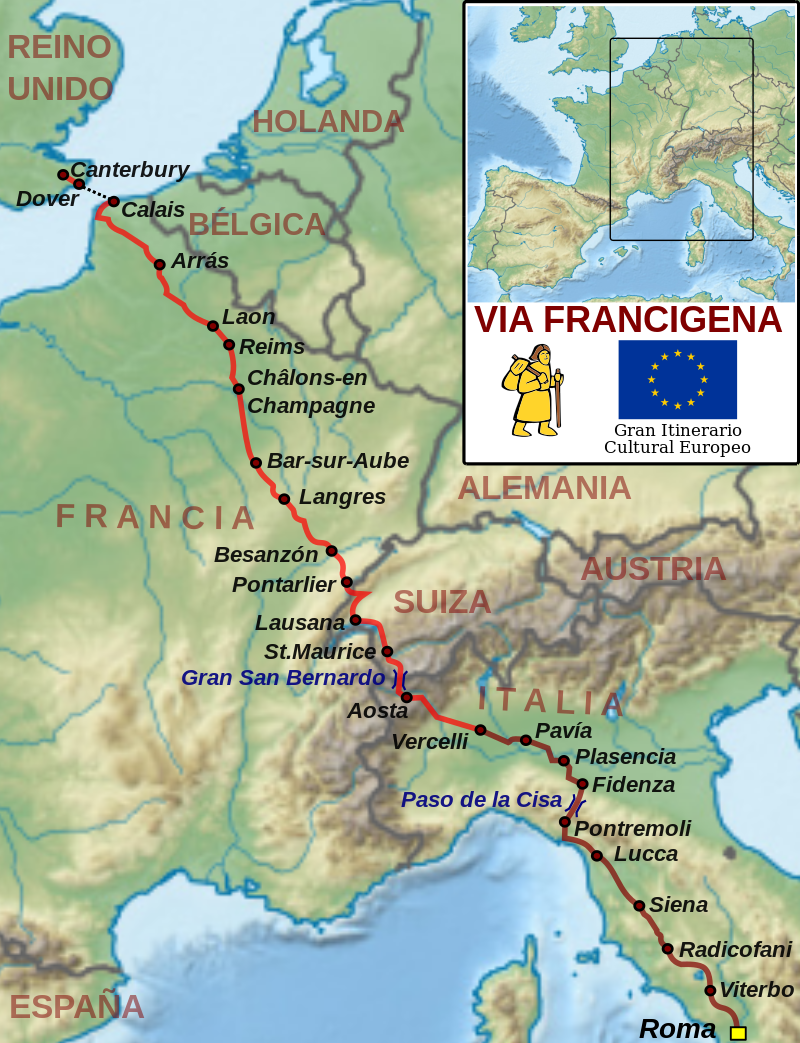PART 95 It might be interesting to share how we pulled off living in Italy for part of the year. I will post some steps and what we are learning along the way.
We love every minute of it, and what was once a dream is our life!
We live in Tuscany in the Fall, then back again in the Spring, and in California for the rest of the time (in a previous blog, I explained why we live in Italy only part of the year).
Step 1: As we explore areas and towns in Italy, we discover some gems worth sharing. Some of these are well-known tourist magnets; others are lesser known but always amazing.

This week, let's explore The Via Francigena
Step 2: What is it?
The Via Francigena is an ancient walking trail that takes pilgrims on a remarkable journey from Canterbury in England, across the channel to France, and through Switzerland before crossing Italy towards Rome.
This is a historic pilgrimage route that has been walked for centuries, similar to the Camino de Santiago. During the medieval era, the Via Francigena played a significant role in connecting Abbeys and Monasteries with the path leading south to Rome, which made it an important road for pilgrims.
Step 3: The Via Francigena in Tuscany
In the 1980s, Italian researchers discovered the travel journal of Abbot Sigerico, named Bishop of Canterbury in 990, in the British Library. In his journal, Sigerico wrote about 80 stops on the Via Francigena between Rome and Canterbury, covering a distance of 587 miles in Italy with 15 stops in the region of Tuscany.

The Via Francigena is a historical European route that crosses Tuscany, offering a unique opportunity to explore almost 400 km of the ancient route that pilgrims, merchants, and travelers once traveled. The journey takes you through forests, hills, and medieval villages, providing glimpses into intriguing history, art, food, and wine. A trip along the Francigena route reveals an incredible beauty from the north to the south of Tuscany.
Step 4: How to walk the Via Francigena
For those who want to complete the entire Via Francigena, starting from Canterbury and ending in Rome, it takes approximately 100 days. However, if you're only interested in day trips, you can hike parts of the route anytime. Alternatively, if you're specifically interested in walking through Tuscany, completing that section of the route should take about a week.
Some of the most beautiful stages of the Francigena in Tuscany include:
San Miniato – Gambassi Terme (24 km/6 hours)
This particular segment of the Via Francigena route takes you through the picturesque hills of Val d'Elsa, characterized by their lush meadows and towering cypress trees. The journey begins from San Miniato, located in the province of Pisa, and spans approximately 24 kilometers. Along the way, you'll be greeted by breathtaking views of fields dotted with ancient farmhouses and farms. The route culminates at the Gambassi thermal baths, an ideal spot to take a break and recharge your batteries.
Gambassi Terme – San Gimignano (13 km/3 hours)

To continue your journey from Gambassi Terme to San Gimignano, you only need to travel 13 kilometers. This route is relatively easy and perfect for cycling. Along the way, you'll come across the Pancole sanctuary, followed by the Romanesque church of Santa Maria Assunta in Cellole. San Gimignano is a remarkable example of medieval town planning and should be explored without rushing.
San Gimignano – Monteriggioni (30 km/7 hours)
This route is widely regarded as one of the most picturesque parts of the Via Francigena. Starting from San Gimignano, the longest path that crosses the region will take you right into the heart of the Tuscan hills, all the way to Abbadia a Isola, an ancient abbey on a patch of land. From there, the journey continues to the village of Monteriggioni, which is surrounded by impressive walls and sturdy towers.
Monteriggioni – Siena (21km/6 hours)
As you walk through Monteriggioni and explore its ancient walls, you can continue along the dirt roads and through meadows and woods until you reach the castles of Chiocciola. If you keep going through Pian del Lago and cross the Renai wood, you will soon see the magnificent outline of Siena, one of the most beautiful cities in Tuscany. Once you reach Siena, stroll along its cobbled streets and visit the stunning Duomo and Piazza del Campo. It's a gratifying experience.
Step 5: Hiking and history

We love hiking because it allows us to explore new areas and enjoy breathtaking views of nature. However, walking along certain sections of the Via Francigena is a unique experience. It makes us feel a strong connection to the rich history of pilgrims, soldiers, saints, sinners, the curious, and the indifferent. This awareness gives our walk a deeper meaning.
Step 6: Resources
There are many online resources where maps of the Via Francigena are broken into small day trips.
For day trips, one can choose a section of the Via Francigena at: https://www.google.com/maps/d/viewer?mid=1025i-0SYMgt3LgGoIy9Fx5Pl4H4&femb=1&ll=43.43094071944643%2C11.037143450000002&z=8
Insights: Stories give meaning to a place, building, monument, or hike. Walking along the Via Francigena makes us part of the great history of stories of those who have walked this path before.
More next time.
Now on sale for $2.99: My book is "Stories from Puglia: Two Californians in Southern Italy." Amazon US: https://www.amazon.com/dp/B0CRKMKPWF?ref_=cm_sw_r_cp_ud_dp_X2WRQ3PTG2ZDD7AVF6GH
Amazon Italy- my book "Lei mi ha sedotto. Una storia d'amore con Roma": https://amzn.eu/d/13nuZCL.





Comments